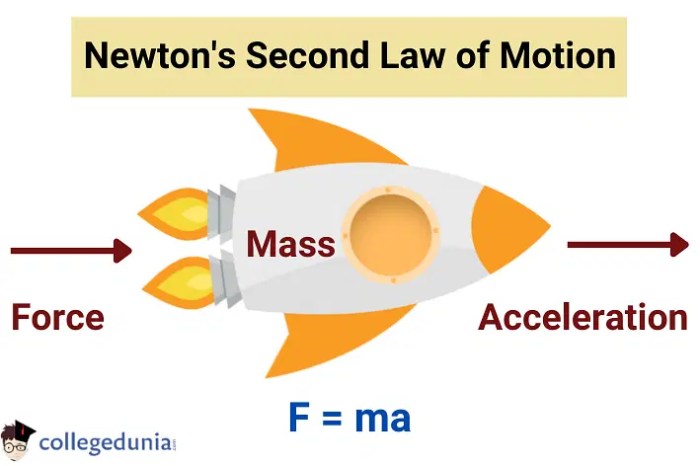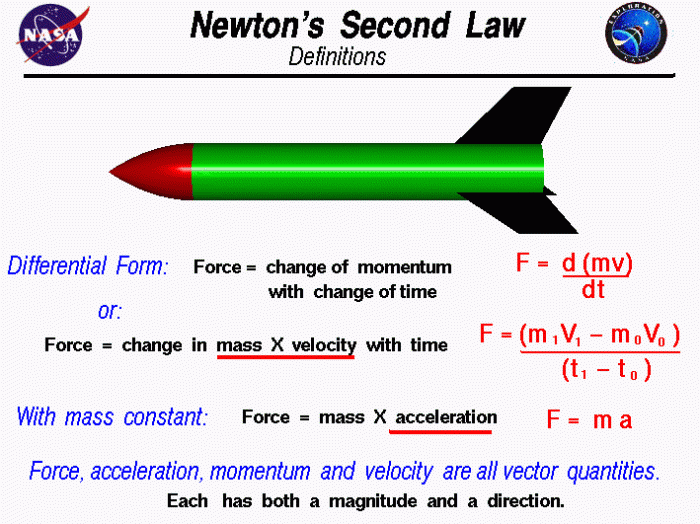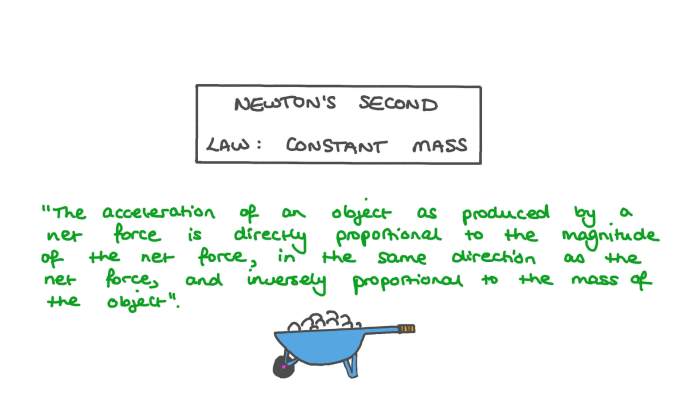
What is newtons second law of motion – What is Newton’s Second Law of Motion? It’s a fundamental principle in physics that describes the relationship between force, mass, and acceleration. This law, discovered by Sir Isaac Newton in the 17th century, is a cornerstone of classical mechanics and explains how objects move in response to forces acting upon them. From the simple act of throwing a ball to the complex workings of a rocket engine, Newton’s Second Law governs the motion of objects around us.
Imagine pushing a heavy box across the floor. The harder you push (greater force), the faster it accelerates. Now, imagine pushing a lighter box. It will accelerate more quickly with the same force. This illustrates the relationship between force, mass, and acceleration as described by Newton’s Second Law.
Newton’s Second Law of Motion
Newton’s Second Law of Motion is a fundamental principle in physics that describes the relationship between an object’s mass, acceleration, and the net force acting upon it. It is one of the most important laws in classical mechanics, providing the foundation for understanding the motion of objects in our everyday world.
This law states that the acceleration of an object is directly proportional to the net force acting on it and inversely proportional to its mass. In simpler terms, the greater the force applied to an object, the greater its acceleration will be. Conversely, the greater the mass of an object, the smaller its acceleration will be for a given force.
Historical Overview
Newton’s Second Law of Motion was first formulated by Sir Isaac Newton in his groundbreaking work, *Philosophiæ Naturalis Principia Mathematica*, published in 1687. This law was a major breakthrough in understanding the motion of objects, providing a mathematical framework for describing and predicting their behavior. Prior to Newton’s work, the understanding of motion was based on the ideas of Aristotle, which were largely qualitative and lacked a rigorous mathematical foundation.
Newton’s Second Law revolutionized the study of motion, laying the groundwork for the development of classical mechanics. It enabled scientists to accurately predict the motion of objects under various conditions, leading to advancements in fields such as astronomy, engineering, and aerospace.
Real-World Applications
Newton’s Second Law has numerous real-world applications across various disciplines. Here are a few examples:
- Vehicle Acceleration: When a car accelerates, the engine provides a force that propels the car forward. The car’s acceleration is directly proportional to the force exerted by the engine and inversely proportional to its mass. A heavier car will require a greater force to achieve the same acceleration as a lighter car.
- Sports: In sports, athletes apply forces to objects or themselves to achieve desired movements. For example, a baseball pitcher exerts a force on the ball to throw it at high speed. The ball’s acceleration is determined by the force applied and its mass. Similarly, a sprinter applies force to their legs to accelerate themselves during a race.
- Rocket Propulsion: Rockets work by expelling hot gases at high velocity. This expulsion of gases creates a force that propels the rocket forward. The rocket’s acceleration is determined by the force generated by the engine and the rocket’s mass. As the rocket burns fuel, its mass decreases, resulting in increased acceleration.
Mathematical Representation
Newton’s Second Law of Motion can be mathematically represented by the following equation:
F = ma
where:
* F represents the net force acting on the object.
* m represents the mass of the object.
* a represents the acceleration of the object.
This equation shows the direct proportionality between force and acceleration and the inverse proportionality between mass and acceleration.
The Mathematical Formulation
Newton’s Second Law of Motion can be expressed mathematically as a simple and elegant equation that captures the fundamental relationship between force, mass, and acceleration.
The Equation
The equation for Newton’s Second Law is:
F = ma
Where:
* F represents the force acting on an object.
* m represents the mass of the object.
* a represents the acceleration of the object.
Defining the Variables
Let’s delve into the meaning of each variable:
* Force (F): Force is a push or pull that can change the motion of an object. It is measured in Newtons (N).
* Mass (m): Mass is a measure of the amount of matter in an object. It is measured in kilograms (kg).
* Acceleration (a): Acceleration is the rate of change of velocity. It is measured in meters per second squared (m/s²).
Relationship between Force, Mass, and Acceleration
The equation F = ma reveals a direct relationship between force, mass, and acceleration. This means:
* Direct Proportionality between Force and Acceleration: If the mass of an object remains constant, the force applied is directly proportional to the acceleration produced. This implies that a larger force will result in a greater acceleration.
* Inverse Proportionality between Mass and Acceleration: For a constant force, the acceleration is inversely proportional to the mass. This means that a heavier object will accelerate less than a lighter object when the same force is applied.
For example, if you push a small car and a large truck with the same force, the car will accelerate faster than the truck because the car has less mass.
Force and Acceleration

Newton’s Second Law of Motion establishes a fundamental relationship between force and acceleration. It states that the acceleration of an object is directly proportional to the net force acting on it and inversely proportional to its mass. In simpler terms, the greater the force applied to an object, the greater its acceleration, and the greater the mass of the object, the smaller its acceleration.
Direct Proportionality Between Force and Acceleration
This relationship between force and acceleration is a direct proportionality. This means that if you double the force applied to an object, you will double its acceleration. Similarly, if you halve the force, you will halve the acceleration. This relationship can be represented mathematically as:
F = ma
where:
* F is the net force acting on the object
* m is the mass of the object
* a is the acceleration of the object
Net Force and its Role in Determining Acceleration
Net force is the vector sum of all the forces acting on an object. It is the overall force that determines the object’s acceleration. If the net force acting on an object is zero, the object will remain at rest or continue moving at a constant velocity. This is known as Newton’s First Law of Motion or the Law of Inertia.
Different Types of Forces
Forces can be categorized based on their nature and origin. Here are some common types of forces:
- Gravitational Force: This is the force of attraction between any two objects with mass. The force of gravity is what keeps us on the ground and what causes the planets to orbit the sun.
- Electromagnetic Force: This force arises from the interaction of charged particles. It is responsible for phenomena like electricity, magnetism, and light.
- Strong Nuclear Force: This force holds the protons and neutrons together in the nucleus of an atom. It is the strongest force in nature.
- Weak Nuclear Force: This force is responsible for radioactive decay. It is weaker than the strong nuclear force but stronger than the electromagnetic force.
- Contact Forces: These forces arise from the direct contact between two objects. Examples include the force of friction, the normal force, and the tension force in a rope.
Mass and Inertia
Inertia is a fundamental property of matter that describes its resistance to changes in motion. It’s a concept that’s deeply intertwined with mass, which is a measure of the amount of matter an object contains.
Inertia and Mass
Inertia and mass are directly proportional; the more mass an object has, the greater its inertia. This means an object with a larger mass will resist changes in motion more strongly than an object with a smaller mass.
Mass Influences Resistance to Changes in Motion
Imagine pushing a shopping cart filled with groceries versus an empty one. The cart with groceries, having more mass, requires a greater force to start moving and to stop once it’s in motion. This is because its inertia is higher due to its greater mass.
Examples of Inertia
Here are some examples illustrating the concept of inertia:
* A passenger in a car suddenly braking: When a car abruptly stops, the passengers continue moving forward due to inertia. This is why seatbelts are crucial; they restrain the passengers and prevent them from being thrown forward.
* A ball rolling on a smooth surface: A ball rolling on a smooth surface will continue rolling until it encounters friction or another force that slows it down. This is due to its inertia; it resists changes in its motion.
* A heavy object at rest: It takes a considerable force to get a heavy object, like a boulder, moving. This is because its large mass gives it a high inertia, making it resist changes in motion.
Applications of Newton’s Second Law: What Is Newtons Second Law Of Motion

Newton’s Second Law of Motion, expressed as F = ma, is a fundamental principle in physics that has far-reaching applications in various fields. It forms the basis for understanding and predicting the motion of objects, from everyday objects to celestial bodies. This law is crucial for engineers in designing structures, machines, and vehicles, ensuring safety and efficiency.
Applications in Different Fields
Newton’s Second Law finds diverse applications across various fields, impacting our understanding of the physical world and influencing technological advancements.
| Field | Application | Example |
|---|---|---|
| Physics | Calculating the motion of objects under the influence of forces | Determining the acceleration of a car when the engine applies a force, or the trajectory of a projectile launched at a certain angle and speed. |
| Engineering | Designing structures, machines, and vehicles to withstand forces and operate safely | Calculating the forces acting on a bridge to ensure its stability, or designing a car’s suspension system to absorb shock and provide a smooth ride. |
| Sports | Analyzing the motion of athletes and equipment | Determining the force a baseball player exerts on a ball to achieve a certain trajectory, or calculating the forces acting on a gymnast during a routine. |
| Aerospace | Designing rockets and spacecraft to navigate and maneuver in space | Calculating the thrust required for a rocket to achieve escape velocity, or determining the forces acting on a spacecraft during atmospheric re-entry. |
Calculating Motion of Objects
Newton’s Second Law is the cornerstone for calculating the motion of objects. By knowing the forces acting on an object and its mass, we can determine its acceleration using the equation F = ma.
The acceleration of an object is directly proportional to the net force acting on it and inversely proportional to its mass.
For example, if a constant force is applied to an object, it will accelerate at a constant rate. If the force is increased, the acceleration will also increase. Conversely, if the mass of the object is increased, the acceleration will decrease.
Engineering Applications
Engineers use Newton’s Second Law extensively in designing structures and machines. This law helps them understand the forces acting on objects and ensure their stability and functionality.
The force required to accelerate an object is equal to the product of its mass and acceleration.
For instance, engineers use this principle to design bridges, buildings, and vehicles that can withstand the forces of gravity, wind, and other loads. They calculate the forces acting on these structures and ensure that they are strong enough to resist these forces.
Examples and Illustrations
Newton’s Second Law of Motion is a fundamental principle that governs the motion of objects. It explains how forces interact with objects to cause them to accelerate. To understand the practical applications of this law, it is helpful to examine real-world examples.
Real-World Examples of Newton’s Second Law
These examples demonstrate the relationship between force, mass, and acceleration in various scenarios.
| Example | Description | Forces Involved | Newton’s Second Law Application |
|---|---|---|---|
| Pushing a Shopping Cart | When you push a shopping cart filled with groceries, you apply a force to it. The heavier the cart (greater mass), the harder you need to push (greater force) to achieve a desired acceleration. | Applied force (pushing), friction (between wheels and floor), gravity (acting on the cart and groceries) | The acceleration of the shopping cart is directly proportional to the net force applied and inversely proportional to its mass. |
| Kicking a Soccer Ball | When you kick a soccer ball, you apply a force to it, causing it to accelerate. The force you apply determines the speed and direction of the ball’s motion. | Applied force (kick), friction (between ball and ground), gravity (acting on the ball) | The acceleration of the soccer ball is directly proportional to the force of the kick and inversely proportional to its mass. |
| Driving a Car | When you press the gas pedal in a car, you increase the engine’s force, causing the car to accelerate. The heavier the car (greater mass), the more force is required to achieve the same acceleration. | Engine force (applied force), friction (between tires and road), air resistance, gravity (acting on the car) | The acceleration of the car is directly proportional to the net force produced by the engine and inversely proportional to its mass. |
| Catching a Baseball | When you catch a baseball, you apply a force to it to slow it down. The faster the ball is moving (greater acceleration), the more force you need to apply to stop it. | Applied force (catching), air resistance, gravity (acting on the ball) | The acceleration of the baseball is directly proportional to the force you apply and inversely proportional to its mass. |
Illustrating Force, Mass, and Acceleration, What is newtons second law of motion
Imagine a simple scenario: a toy car on a flat surface. If you push the car with a small force, it will accelerate slowly. If you push it with a larger force, it will accelerate faster. This demonstrates the direct relationship between force and acceleration.
Now, consider two toy cars, one heavier than the other. If you push both cars with the same force, the lighter car will accelerate faster than the heavier car. This illustrates the inverse relationship between mass and acceleration.
The relationship between force, mass, and acceleration can be visualized as follows:
* Force: Represented by the length of an arrow. A longer arrow indicates a greater force.
* Mass: Represented by the size of the object. A larger object indicates a greater mass.
* Acceleration: Represented by the direction and length of the arrow. A longer arrow indicates a greater acceleration in the direction of the arrow.
In summary, Newton’s Second Law of Motion is a fundamental principle that explains how forces cause objects to accelerate. By understanding this law, we can analyze and predict the motion of objects in various real-world situations.
Last Word

Newton’s Second Law of Motion is a powerful tool for understanding and predicting the motion of objects. It has wide-ranging applications in various fields, from engineering and physics to sports and everyday life. By understanding the interplay of force, mass, and acceleration, we can gain insights into the world around us and unlock the secrets of motion.
Essential FAQs
What is the significance of Newton’s Second Law of Motion?
Newton’s Second Law of Motion is significant because it provides a fundamental understanding of how forces affect the motion of objects. It allows us to predict and explain the behavior of objects in various situations, from simple everyday occurrences to complex engineering applications.
How does Newton’s Second Law apply to everyday life?
Newton’s Second Law is present in many everyday situations. For example, when you push a shopping cart, you apply a force that causes it to accelerate. When you brake your car, you apply a force that causes it to decelerate. The force of gravity pulls objects towards the Earth, causing them to accelerate downwards.
Can Newton’s Second Law be used to explain the motion of objects in space?
Yes, Newton’s Second Law applies to objects in space as well. It explains the motion of planets around the sun, the orbits of satellites, and the trajectories of spacecraft. However, in space, the gravitational force is the dominant force acting on objects.
What are some limitations of Newton’s Second Law?
Newton’s Second Law is a classical law of motion and does not hold true at very high speeds or in very strong gravitational fields. In these cases, we need to consider the principles of special and general relativity, which are more accurate descriptions of motion in these extreme situations.




